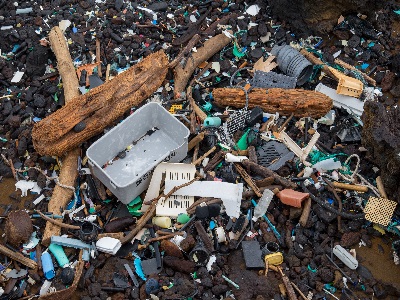 Nakatane
Town Beach Pollution Nakatane
Town Beach Pollution
中種子町海岸汚染
Note: The information on this page
was translated from English to Japanese using Google
Translate.
注: このページの情報は、Google
翻訳を使用して英語から日本語に翻訳されています。
For three years we lived in the
Nishino District of Minamitane Town on Tanegashima Island.
After a few months in America we returned to the
island and purchased a property in the Noma District of
Nakatane Town. We were amazed at the amount of trash
littered all over the beaches. The beaches in this town are
made up sand, or rocks and boulders, or a combination of
both. The rock and boulder beaches are loaded with trash,
much of which gets wedged between the crevices. For these
beaches, trash removal is problematic partially due to
difficult access. I suppose this could almost be used as an
excuse for not doing trash removal. The trash on the sand
beaches, on the other hand, is easily removed by hand or
with heavy machinery like backhoes, or tractors with huge
rakes.
私たちは種子島の南種子町西野地区に3年間住んでいました。アメリカで数か月過ごした後、私たちは島に戻り、中種子町野間地区に不動産を購入しました。私たちはビーチのいたるところに散らばっているゴミの量に驚きました。この町のビーチは、砂、岩と岩、あるいはその両方の組み合わせで構成されています。岩や岩のビーチにはゴミがたくさんあり、その多くは隙間に挟まれています。これらのビーチでは、アクセスが難しいこともあり、ゴミの除去が問題となっています。これは、ゴミ捨てをしない言い訳にもなりそうな気がします。一方、砂浜のゴミは手で、またはバックホウや巨大なレーキを備えたトラクターなどの重機を使って簡単に取り除くことができます。 |
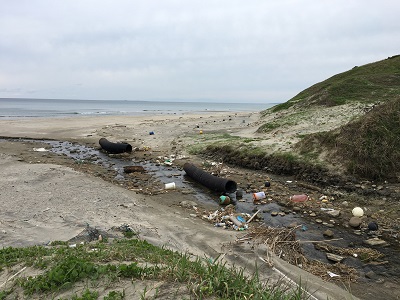 Nagahama
Beach Nagahama
Beach
長浜海岸
Nagahama Beach is located on the west side of the island in
Nakatane Town. Nagahama Beach means "long beach" in
Japanese, and as the name implies, this beach is probably
the longest on the entire island. This beach also has the
unfortunate designation of being one of the most polluted
beaches on the island.
長浜海水浴場は中種子町の島の西側にあります。長浜海水浴場は日本語で「長い砂浜」を意味し、その名が示すとおり、このビーチはおそらく島全体で最も長いビーチです。このビーチは、残念なことに、島で最も汚染されたビーチの
1 つとして指定されています。
These is trash everywhere including, but not limited to:
plastic bags, balloons, buoys, rope, medical waste, glass
and plastic bottles, cigarette stubs, cigarette lighters,
beverage cans, polystyrene, lost fishing line and nets, and
various wastes from ships are among the items commonly found
to have washed ashore. The situation is the same on the
other side of the island as well.
これらはどこにでもあるゴミで、ビニール袋、風船、ブイ、ロープ、医療廃棄物、ガラスとペットボトル、タバコの吸い殻、ライター、飲料缶、ポリスチレン、紛失した釣り糸と網、船からのさまざまな廃棄物が含まれますが、これらに限定されません。漂着したものがよく発見されるものの一つです。島の反対側でも状況は同じです。
Nakatane Town has no problem investing money in facilities
to be used in connection with the Japanese and American
militaries but seems to have no interest in looking after
their beaches. We listened to stories of surfers who picked
up trash at some of the Nakatane beaches and dumped the
trash at the entrance of the town administration building.
中種子町は日米両軍関連の施設に資金を投資することに問題はないが、海岸の手入れには関心がないようだ。中種子海岸の一部でゴミを拾い、町役場入口にゴミを捨てたサーファーたちの話を聞いた。
During the last few years, my family has been picking up
trash on two of our local beaches, Takeyano and Kumano Yoko.
Because we use these beaches often, we feel it is our duty
to keep these beaches trash free.
ここ数年、私の家族は地元の 2
つの海岸、竹谷野海岸と熊野横浜でゴミ拾いをしています。私たちはこれらのビーチを頻繁に利用するため、これらのビーチをゴミのない状態に保つことが私たちの義務であると感じています。 |
|
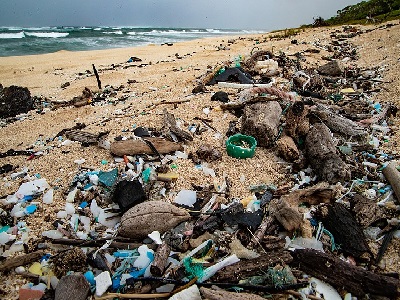 Beach
Trash Explained Beach
Trash Explained
ビーチゴミの説明
Beach trash, also known as marine debris, or marine litter,
is human-created solid material that has deliberately or
accidentally been released in a sea or ocean. Floating
oceanic debris tends to accumulate at the center of gyres
and on coastlines, frequently washing aground, when it is
known as beach litter. Deliberate disposal of wastes at sea
is called ocean dumping. Naturally occurring debris, such as
driftwood and drift seeds, are also present. With the
increasing use of plastic, human influence has become an
issue as many types of (petrochemical) plastics do not
biodegrade quickly, as would natural or organic materials.
The largest single type of plastic pollution (~10%) and the
majority of large plastic in the oceans is discarded and
lost nets from the fishing industry. Waterborne plastic
poses a serious threat to fish, seabirds, marine reptiles,
and marine mammals, as well as to boats and coasts.
海洋ゴミまたは海洋ゴミとしても知られるビーチゴミは、意図的または偶然に海または海に放出された、人間が作り出した固形物質です。浮遊海洋ゴミは環流の中心や海岸線に蓄積する傾向があり、頻繁に座礁し、海岸ゴミとして知られています。廃棄物を意図的に海洋に投棄することを海洋投棄といいます。流木や漂流種子などの自然由来のゴミも存在します。多くの種類の(石油化学)プラスチックは、天然素材や有機素材とは異なり、すぐには生分解されないため、プラスチックの使用が増加するにつれて、人間の影響が問題になっています。単一の種類のプラスチック汚染の中で最大のもの(約
10%)があり、海洋の大型プラスチックの大部分は、漁業から廃棄されたり網が失われたりしています。水系プラスチックは、ボートや海岸だけでなく、魚、海鳥、海洋爬虫類、海洋哺乳類にも深刻な脅威をもたらします。
Dumping, container spillages, litter washed into storm
drains and waterways and wind-blown landfill waste all
contribute to this problem. This increased water pollution
has caused serious negative effects such as discarded
fishing nets capturing animals, concentration of plastic
debris in massive marine garbage patches, and increasing
concentrations of contaminants in the food chain.
投棄、コンテナの流出、雨水管や水路に流れ込んだゴミ、風に飛ばされた埋め立て廃棄物はすべて、この問題の一因となります。この水質汚染の増加は、動物を捕らえた漁網の廃棄、大量の海洋ゴミ地帯へのプラスチックごみの集中、食物連鎖における汚染物質の濃度の増加など、深刻な悪影響を引き起こしています。 |
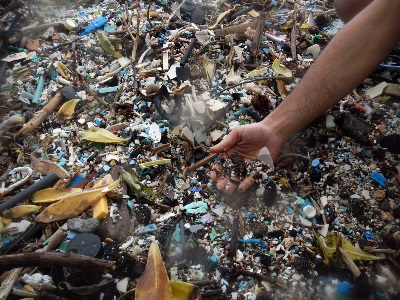 Beach
Trash Types Beach
Trash Types
ビーチゴミの種類
Researchers classify debris as either land- or ocean-based;
in 1991, the United Nations Joint Group of Experts on the
Scientific Aspects of Marine Pollution estimated that up to
80% of the pollution was land-based, with the remaining 20%
originating from catastrophic events or maritime sources.
研究者はデブリを陸上のものと海洋のものに分類しています。
1991年、海洋汚染の科学的側面に関する国連専門家合同グループは、汚染の最大80%が陸上由来で、残りの20%は壊滅的な出来事または海洋発生源に由来すると推定した。
A wide variety of man-made objects can become marine debris;
plastic bags, balloons, buoys, rope, medical waste, glass
and plastic bottles, cigarette stubs, cigarette lighters,
beverage cans, polystyrene, lost fishing line and nets, and
various wastes from cruise ships and oil rigs are among the
items commonly found to have washed ashore. Six-pack rings,
in particular, are considered emblematic of the problem.
さまざまな人工物が海洋ゴミになる可能性があります。ビニール袋、風船、ブイ、ロープ、医療廃棄物、ガラスやペットボトル、タバコの吸い殻、ライター、飲料缶、ポリスチレン、紛失した釣り糸や網、クルーズ船や石油掘削装置からのさまざまな廃棄物などが一般的に見つかります。岸に打ち上げられました。特にシックスパックリングはこの問題の象徴であると考えられている。 |
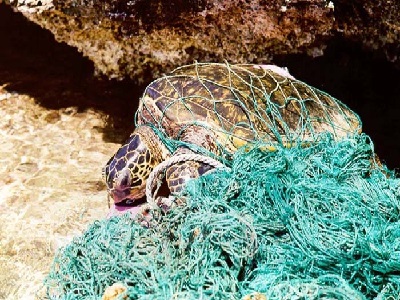 Ghost
nets Ghost
nets
ゴーストネット
Ghost nets are fishing nets that have been abandoned, lost,
or otherwise discarded in the ocean. These nets, often
nearly invisible in the dim light, can be left tangled on a
rocky reef or drifting in the open sea. They can entangle
fish, dolphins, sea turtles, sharks, dugongs, crocodiles,
seabirds, crabs, and other creatures, including the
occasional human diver. Acting as designed, the nets
restrict movement, causing starvation, laceration and
infection, and suffocation in those that need to return to
the surface to breathe. It's estimated that around 48,000
tons of ghost nets are generated each year, and these may
linger in the oceans for a considerable time before
breaking-up.
ゴーストネットは、海に放棄、紛失、または廃棄された漁網です。これらの網は、薄明かりの中でほとんど見えないことが多く、岩礁に絡まったままになったり、外海に漂流したりすることがあります。魚、イルカ、ウミガメ、サメ、ジュゴン、ワニ、海鳥、カニ、その他の生き物、時には人間のダイバーも絡むことがあります。設計どおりに機能すると、ネットは動きを制限し、呼吸のために水面に戻る必要がある人に飢え、裂傷、感染、窒息を引き起こします。毎年約
48,000
トンのゴーストネットが発生すると推定されており、これらは分解されるまでかなりの期間海中に残る可能性があります。 |
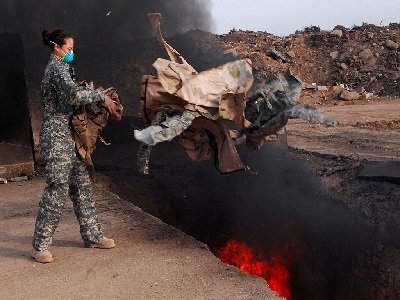 Military
Trash Military
Trash
軍事ゴミ
The US military used ocean dumping for unused weapons and
bombs, including ordinary bombs, UXO, landmines and chemical
weapons from at least 1919 until 1970. Millions of pounds of
ordnance were disposed of in the Gulf of Mexico and off the
coasts of at least 16 states, from New Jersey to Hawaii
(although these, of course, do not wash up onshore, and the
US is not the only country who has practiced this).
米軍は、少なくとも1919年から1970年まで、通常の爆弾、不発弾、地雷、化学兵器を含む未使用の武器や爆弾の海洋投棄を行った。数百万ポンドの兵器がメキシコ湾と少なくとも16の海域の沖合で処分された。ニュージャージー州からハワイ州に至るまで(もちろん、これらは陸上に打ち上げられるわけではなく、これを実践しているのは米国だけではありません)。 |
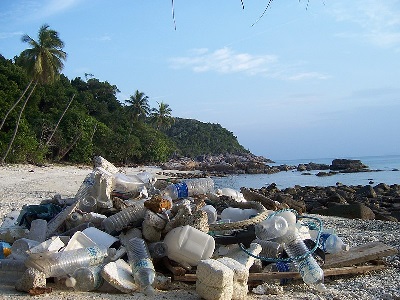 Plastic
Trash Plastic
Trash
プラスティックゴミ
Eighty percent of marine debris is plastic. Plastics
accumulate because they typically do not biodegrade as many
other substances do. They photodegrade on exposure to
sunlight, although they do so only under dry conditions, as
water inhibits photolysis. In a 2014 study using computer
models, scientists from the group 5 Gyres, estimated 5.25
trillion pieces of plastic weighing 269,000 tons were
dispersed in oceans in similar amount in the Northern and
Southern Hemispheres.
海洋ゴミの80%はプラスチックです。プラスチックは通常、他の多くの物質とは異なり生分解しないため、蓄積します。これらは太陽光にさらされると光分解しますが、水は光分解を阻害するため、乾燥した条件下でのみ光分解します。コンピューターモデルを使った2014年の研究では、グループ5ジャイレスの科学者らは、重さ26万9000トンに相当する5兆2500億個のプラスチックが北半球と南半球で同量の海洋に分散していると推定した。 |
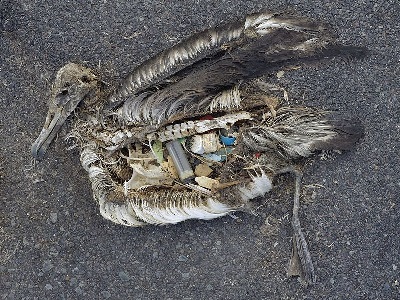 Beach
Trash Impacts Beach
Trash Impacts
ビーチゴミの影響
Many animals that live on or in the sea consume trash by
mistake (see picture), as it often looks similar to their
natural prey. Overall, 1288 marine species are known to
ingest plastic debris, with fish making up the largest
fraction. Bulky plastic debris may become permanently lodged
in the digestive tracts of these animals, blocking the
passage of food and causing death through starvation or
infection. Tiny floating plastic particles also resemble
zooplankton, which can lead filter feeders to consume them
and cause them to enter the ocean food chain. In addition,
plastic in the marine environment that contaminates the food
chain can have repercussions on the viability of fish and
shellfish species.
海の上や海に生息する多くの動物は、ゴミが自然の獲物に似ていることが多いため、誤ってゴミを食べてしまいます(写真を参照)。全体として、1,288
の海洋生物種がプラスチックの破片を摂取することが知られており、魚が最も大きな割合を占めています。かさばるプラスチックの破片がこれらの動物の消化管に永久に詰まり、食物の通過を妨げ、飢餓や感染症によって死亡する可能性があります。浮遊する小さなプラスチック粒子も動物プランクトンに似ており、濾過摂食者がそれらを消費し、海の食物連鎖に入る原因となる可能性があります。さらに、食物連鎖を汚染する海洋環境のプラスチックは、魚介類の生存能力に影響を与える可能性があります。 |
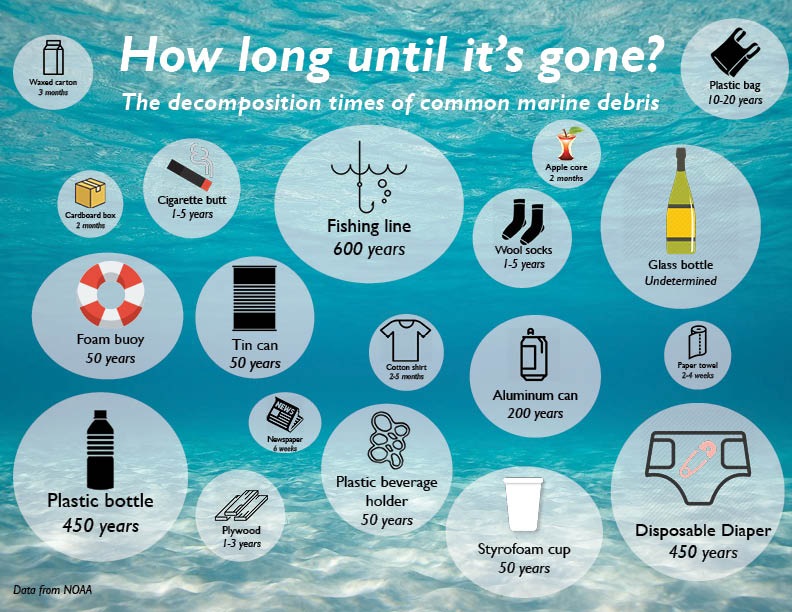 |
Beach Trash Decomposition
ビーチゴミの分解
There are two causes of the degradation of marine ecology
and marine debris: the direct forces (population growth,
technological development, and economic growth) and
proximity forces (land transformation and industrial
processes). We can think of the direct forces as underlying
causes of why we consume an excessive amount of goods by
industry process. The excessive consumption of goods causes
marine debris because the goods have been packaged by
manufactured cheap non-recycle materials such as plastic.
Solid waste plastics cannot decompose easily in nature and
their decomposition process takes thousands of years to
millions of years but plastic breaks down into continuously
smaller pieces (>5 mm) forming what is called
micro-plastics. Thus, such solid waste products are called
marine debris that can be seen all through coastlines and on
many beaches through the world. There can be many sources of
marine debris such as land-based, marine-based, and other
anthropocentric activities.
海洋生態系と海洋ゴミの劣化には、直接的な影響 (人口増加、技術開発、経済成長) と近接的な影響
(土地の変化や産業プロセス) の 2
つの原因があります。私たちが産業プロセスごとに過剰な量の商品を消費する根本的な原因として直接的な要因があると考えることができます。商品はプラスチックなどの安価な非リサイクル材料で梱包されているため、商品の過剰消費は海洋ゴミの原因となります。固体の廃プラスチックは自然界では容易に分解できず、その分解プロセスには数千年から数百万年かかりますが、プラスチックは継続的に小さな破片(>5
mm)に分解され、いわゆるマイクロプラスチックを形成します。したがって、そのような固形廃棄物は海洋ゴミと呼ばれ、世界中の海岸線や多くのビーチで見られます。海洋ゴミの発生源は、陸上、海洋、その他の人類中心の活動など、数多く存在する可能性があります。 |
|